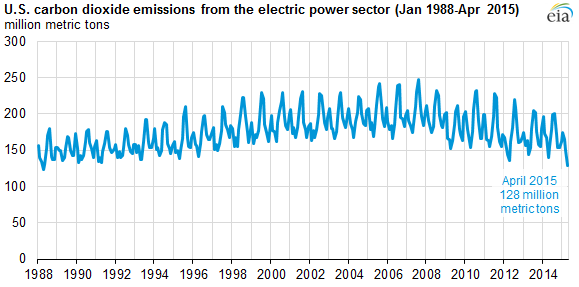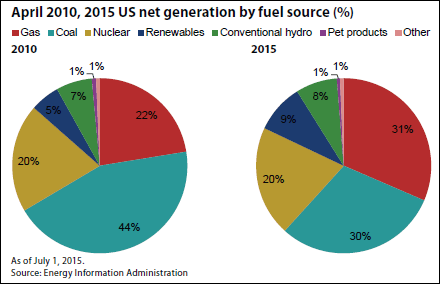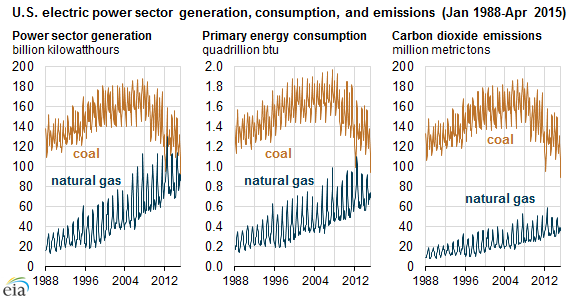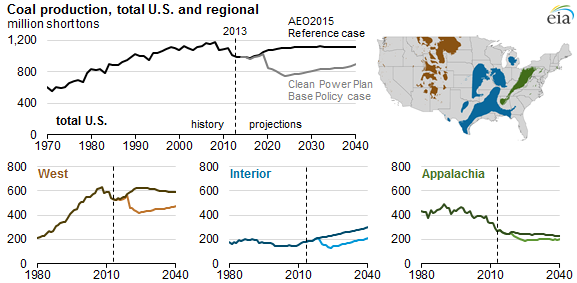Carbon emissions from the power sector at lowest level since 1988
The electric power sector emitted 128 million metric tons of carbon dioxide (MMmt CO2) in April 2015, according to information from the Energy Information Administration (EIA). This level of emissions is the lowest for any month since April 1988.
In any year, April is typically the month with the lowest carbon dioxide emissions from the electric power sector, mainly because of mild weather. In April 2015, electricity generated from both coal and natural gas fell from their March levels, but because coal fell further than natural gas (18% versus 6%, respectively), generation from natural gas surpassed generation from coal for the month.
April 2015 marked the first time ever that natural gas generated more electricity than coal in the United States. According to the EIA, in April, natural gas created 92,516 megawatt hours (Mwh) of electrical power, while coal was responsible for 88,835 Mwh of electricity. Just a month prior, coal generated 9,753 Mwh more than coal, with 108,642 Mwh of power generation, while natural gas was used to create 98,889 Mwh of electricity.
Natural gas has been steadily gaining a larger share of power generation, making up 31% of total generation in April 2015, up from 22% in April 2010. Electrical generation from coal has steadily declined over the same period, falling to 30% from 44% in the same time frame.
The EPA releases the final version of the Clean Power Plan
On August 3, the Environmental Protection Agency (EPA) released the final version of its proposed Clean Power Plan, setting its emissions reduction goal 2% higher than in the last draft, released in June 2014. The final version of the Clean Power Plan is targeting carbon emission levels 32% below those in 2005 by 2030.
The goal of the CPP is to reduce U.S. greenhouse gas emissions, nearly three-quarters of which come from CO2 emissions. The EPA notes, that while “fossil fuels will continue to be a critical component of America’s energy future,” they are also the largest source of CO2 emissions, making them the primary target of the new regulations.
According to the EIA, more electricity is being generated from sources that do not release carbon dioxide as part of the generating process, as the industrial electrical generation sector moves towards more environmentally friendly power sources. Nuclear power generation increased 3% for the first four months of 2015 compared with the first four months of 2014, and renewable energy generation increased by 2% over the first four months of 2014.
Although wind generation fell 7% because of relatively low wind resources, hydroelectric generation, which accounts for about half of all renewable energy generation in the electric power sector, increased 7%.
Clean Power Plan may mean 32% more natural gas use
Analysts at Sanford C. Bernstein & Co. said they expect the rule would increase utility consumption of natural gas by 7.1 Bcf/d, or 32%, enough to increase national demand by 10%. The coal industry, on the other hand, will likely see consumption drop 23% by 2020.
While the bill is expected to boost support for natural gas use in industrial electricity, many in the industry say the version of the bill released in 2014 offered more for the natural gas industry. Nick Akins, CEO of Ohio-based American Electric Power Co. (ticker: AEP) said utilities are already moving to reduce emissions, but the plan could mean closing plants that are not paid off. This means consumers will have to pay for assets that do not provide them benefits, Akins told The Wall Street Journal. Despite this, Akins says utilities “will be reaching out to our states and be very factual and objective and see if we can comply.”
Other industry executives are concerned that the new rule seeks to prevent a wholesale shift to natural gas. The version of the Clean Power Plan released in 2014 relied on a large shift from coal to natural gas. The final regulation would remove that assumption and encourage states to move towards renewable projects. “We’re disappointed and discouraged that they [the administration] seem to be ignoring the fact that natural gas has greatly reduced emissions,” said Marty Durbin, CEO of America’s Natural Gas Alliance.
Litigation expected
More than a dozen states and the coal industry have promised to sue the EPA, with several states saying they will not comply. A note from Raymond James said, “new regulations start the clock on the inevitable litigation from the plan’s opponents.”
Most recently, the Supreme Court struck down the EPA’s Clean Air Act in a 5-to-4 decision, in which the EPA did not consider the costs to the power generation industry. The bill would have cost the industry an estimated $9.6 billion a year annually for $4-$6 million in benefits. Associate Justice Antonin Scalia said “EPA strayed far beyond [the bounds of reasonable interpretation] when it read [The Clean Air Act] to mean it could ignore cost when deciding whether to regulate power plants.”
Laurence Tribe, professor of constitutional law at Harvard University, said the version of the Clean Power Plan released last year was predicated on a flawed legal justification. The CPP is enforced through Section 111 of the Clean Air Act, but Tribe said, “This part of the law expressly says that it may not be used to regulate power plants where, as is the case in this situation, those plants are already being regulated as Congress contemplated under another part of the law, Section 112.”
The power generation industry is expected to spend more than $100 billion next year on capital projects, and will adjust its spending programs to reflect the new rules even as court challenges proceed, according to experts.





